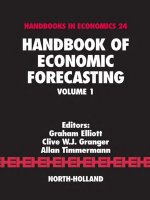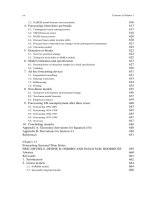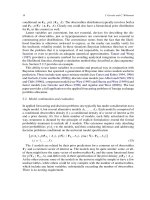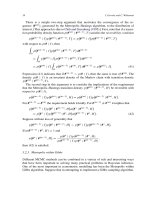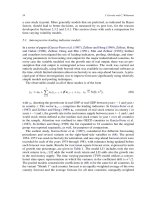Handbook of Economic Forecasting part 6 ppsx
Bạn đang xem bản rút gọn của tài liệu. Xem và tải ngay bản đầy đủ của tài liệu tại đây (172.65 KB, 10 trang )
24 J. Geweke and C. Whiteman
requirement is equivalent to a record of the one-step-ahead predictive likelihoods p(y
o
t
|
Y
o
t−1
,A
j
)(t = 1, ,T) for each model. It is therefore not surprising that most of
the prediction work based on model combination has been undertaken using models
also designed by the combiners. The feasibility of this approach was demonstrated by
Zellner and coauthors [Palm and Zellner (1992), Min and Zellner (1993)] using purely
analytical methods. Petridis et al. (2001) provide a successful forecasting application
utilizing a combination of heterogeneous data and Bayesian model averaging.
2.4.4. Conditional forecasting
In some circumstances, selected elements of the vector of future values of y may be
known, making the problem one of conditional forecasting. That is, restricting attention
to the vector of interest ω = (y
T +1
, ,y
T +F
)
, one may wish to draw inferences
regarding ω treating (S
1
y
T +1
, ,S
F
y
T +F
) ≡ Sω as known for q × p “selection”
matrices (S
1
, ,S
F
), which could select elements or linear combinations of elements
of future values. The simplest such situation arises when one or more of the elements
of y become known before the others, perhaps because of staggered data releases. More
generally, it may be desirable to make forecasts of some elements of y given views
that others follow particular time paths as a way of summarizing features of the joint
predictive distribution for (y
T +1
, ,y
T +F
).
In this case, focusing on a single model, A, (25) becomes
(32)p
ω | Sω, Y
o
T
,A
=
A
p
θ
A
| Sω, Y
o
T
,A
p
ω | Sω, Y
o
T
, θ
A
dθ
A
.
As noted by Waggoner and Zha (1999), this expression makes clear that the conditional
predictive density derives from the joint density of θ
A
and ω. Thus it is not sufficient,
for example, merely to know the conditional predictive density p(ω | Y
o
T
, θ
A
), because
the pattern of evolution of (y
T +1
, ,y
T +F
) carries information about which θ
A
are
likely, and vice versa.
Prior to the advent of fast posterior simulators, Doan, Litterman and Sims (1984)
produced a type of conditional forecast from a Gaussian vector autoregression (see (3))
by working directly with the mean of p(ω | Sω, Y
o
T
,
¯
θ
A
), where
¯
θ
A
is the posterior
mean of p(θ
A
| Y
o
T
,A). The former can be obtained as the solution of a simple least
squares problem. This procedure of course ignores the uncertainty in θ
A
.
More recently, Waggoner and Zha (1999) developed two procedures for calculating
conditional forecasts from VARs according to whether the conditions are regarded as
“hard” or “soft”. Under “hard” conditioning, Sω is treated as known, and (32) must be
evaluated. Waggoner and Zha (1999) develop a Gibbs sampling procedure to do so. Un-
der “soft” conditioning, Sω is regarded as lying in a pre-specified interval, which makes
it possible to work directly with the unconditional predictive density (25), obtaining a
sample of Sω in the appropriate interval by simply discarding those samples Sω which
do not. The advantage to this procedure is that (25) is generally straightforward to ob-
tain, whereas p(ω | Sω, Y
o
T
, θ
A
) may not be.
Ch. 1: Bayesian Forecasting 25
Robertson, Tallman and Whiteman (2005) provide an alternative to these condi-
tioning procedures by approximating the relevant conditional densities. They spec-
ify the conditioning information as a set of moment conditions (e.g., ESω =
ˆ
ω
S
;
E(Sω −
ˆ
ω
S
)(Sω −
ˆ
ω
S
)
= V
ω
), and work with the density (i) that is closest to the
unconditional in an information-theoretic sense and that also (ii) satisfies the speci-
fied moment conditions. Given a sample {ω
(m)
} from the unconditional predictive, the
new, minimum-relative-entropy density is straightforward to calculate; the original den-
sity serves as an importance sampler for the conditional. Cogley, Morozov and Sargent
(2005) have utilized this procedure in producing inflation forecast fan charts from a
time-varying parameter VAR.
3. Posterior simulation methods
The principle of relevant conditioning in Bayesian inference requires that one be able
to access the posterior distribution of the vector of interest ω in one or more models.
In all but simple illustrative cases this cannot be done analytically. A posterior simula-
tor yields a pseudo-random sequence {ω
(1)
, ,ω
(M)
} that can be used to approximate
posterior moments of the form E[h(ω) | Y
o
T
,A] arbitrarily well: the larger is M,the
better is the approximation. Taken together, these algorithms are known generically as
posterior simulation methods. While the motivating task, here, is to provide a simula-
tion representative of p(ω | Y
o
T
,A), this section will both generalize and simplify the
conditioning, in most cases, and work with the density p(θ | I), θ ∈ ⊆ R
k
, and
p(ω | θ ,I), ω ∈ ⊆ R
q
, I denoting “information”. Consistent with the motivating
problem, we shall assume that there is no difficulty in drawing ω
(m)
iid
∼ p(ω | θ,I).
The methods described in this section all utilize as building blocks the set of distrib-
utions from which it is possible to produce pseudo-i.i.d. sequences of random variables
or vectors. We shall refer to such distributions as conventional distributions. This set
includes, of course, all of those found in standard mathematical applications software.
There is a gray area beyond these distributions; examples include the Dirichlet (or mul-
tivariate beta) and Wishart distributions. What is most important, in this context, is that
posterior distributions in all but the simplest models lead almost immediately to dis-
tributions from which it is effectively impossible to produce pseudo-i.i.d. sequences of
random vectors. It is to these distributions that the methods discussed in this section
are addressed. The treatment in this section closely follows portions of Geweke (2005,
Chapter 4).
3.1. Simulation methods before 1990
The applications of simulation methods in statistics and econometrics before 1990, in-
cluding Bayesian inference, were limited to sequences of independent and identically
distributed random vectors. The state of the art by the mid-1960s is well summa-
rized in Hammersly and Handscomb (1964) and the early impact of these methods in
26 J. Geweke and C. Whiteman
Bayesian econometrics is evident in Zellner (1971). A survey of progress as of the end
of this period is Geweke (1991) written at the dawn of the application of Markov chain
Monte Carlo (MCMC) methods in Bayesian statistics.
1
Since 1990 MCMC methods
have largely supplanted i.i.d. simulation methods. MCMC methods, in turn, typically
combine several simulation methods, and those developed before 1990 are important
constituents in MCMC.
3.1.1. Direct sampling
In direct sampling θ
(m)
iid
∼ p(θ | I).Ifω
(m)
∼ p(ω | θ
(m)
,I) is a conditionally
independent sequence, then {θ
(m)
, ω
(m)
}
iid
∼ p(θ | I)p(ω | θ,I). Then for any existing
moment E[h(θ, ω) | I ], M
−1
M
m=1
h(θ
(m)
, ω
(m)
)
a.s.
→ E[h(θ, ω) | I ]; this property,
for any simulator, is widely termed simulation-consistency. An entirely conventional
application of the Lindeberg–Levy central limit theorem provides a basis of assessing
the accuracy of the approximation. The conventional densities p(θ | I) from which
direct sampling is possible coincide, more or less, with those for which a fully analytical
treatment of Bayesian inference and forecasting is possible. An excellent example is the
fully Bayesian and entirely analytical solution of the problem of forecasting turning
points by Min and Zellner (1993).
The Min–Zellner treatment addresses only one-step-ahead forecasting. Forecasting
successive steps ahead entails increasingly nonlinear functions that rapidly become in-
tractable in a purely analytical approach. This problem was taken up in Geweke (1988)
for multiple-step-ahead forecasts in a bivariate Gaussian autoregression with a con-
jugate prior distribution. The posterior distribution, like the prior, is normal-gamma.
Forecasts F steps ahead based on a quadratic loss function entail linear combinations of
posterior moments of order F from a multivariate Student-t distribution. This problem
plays to the comparative advantage of direct sampling in the determination of posterior
expectations of nonlinear functions of random variables with conventional distributions.
It nicely illustrates two variants on direct sampling that can dramatically increase the
speed and accuracy of posterior simulation approximations.
1. The first variant is motivated by the fact that the conditional mean of the F -step
ahead realization of y
t
is a deterministic function of the parameters. Thus, the
function of interest ω is taken to be this mean, rather than a simulated realization
of y
t
.
2. The second variant exploits the fact that the posterior distribution of the variance
matrix of the disturbances (denoted θ
2
, say) in this model is inverted Wishart, and
1
Ironically, MCMC methods were initially developed in the late 1940’s in one of the first applications of
simulation methods using electronic computers, to the design of thermonuclear weapons[see Metropolis et al.
(1953)]. Perhaps not surprisingly, they spread first to disciplines with the greatest access to computing power:
see the application to image restoration by Geman and Geman (1984).
Ch. 1: Bayesian Forecasting 27
the conditional distribution of the coefficients (θ
1
, say) is Gaussian. Correspond-
ing to the generated sequence θ
(m)
1
, consider also
θ
(m)
1
= 2E(θ
1
| θ
(m)
2
,I)−θ
(m)
1
.
Both θ
(m)
= (θ
(m)
1
, θ
(m)
2
) and
θ
(m)
= (
θ
(m)
1
, θ
(m)
2
) are i.i.d. sequences drawn
from p(θ | I).Takeω
(m)
∼ p(ω | θ
(m)
,I) and ω
(m)
∼ p(ω |
θ
(m)
,I). (In the
forecasting application of Geweke (1988) these latter distributions are determin-
istic functions of θ
(m)
and
θ
(m)
.) The sequences h(ω
(m)
) and h(ω
(m)
) will also be
i.i.d. and, depending on the nature of the function h, may be negatively correlated
because cov(θ
(m)
1
,
θ
(m)
1
,I) =−var(θ
(m)
1
| I) =−var(
θ
(m)
1
| I). In many cases
the approximation error occurred using (2M)
−1
M
m=1
[h(ω
(m)
) + h(ω
(m)
)] may
be much smaller than that occurred using M
−1
M
m=1
h(ω
(m)
).
The second variant is an application of antithetic sampling, an idea well established
in the simulation literature [see Hammersly and Morton (1956) and Geweke (1996a,
Section 5.1)]. In the posterior simulator application just described, given weak regular-
ity conditions and for a given function h, the sequences h(ω
(m)
) and h(ω
(m)
) become
more negatively correlated as sample size increases [see Geweke (1988, Theorem 1)];
hence the term antithetic acceleration. The first variant has acquired the monicker
Rao–Blackwellization in the posterior simulation literature, from the Rao–Blackwell
Theorem, which establishes var[E(ω | θ ,I)] var(ω | I). Of course the two meth-
ods can be used separately. For one-step ahead forecasts, the combination of the two
methods drives the variance of the simulation approximation to zero; this is a close re-
flection of the symmetry and analytical tractability exploited in Min and Zellner (1993).
For near-term forecasts the methods reduce variance by more than 99% in the illus-
tration taken up in Geweke (1988); as the forecasting horizon increases the reduction
dissipates, due to the increasing nonlinearity of h.
3.1.2. Acceptance sampling
Acceptance sampling relies on a conventional source density p(θ | S) that approxi-
mates p(θ | I), and then exploits an acceptance–rejection procedure to reconcile the
approximation. The method yields a sequence θ
(m)
iid
∼ p(θ | I); as such, it renders the
density p(θ | I) conventional, and in fact acceptance sampling is the “black box” that
produces pseudo-random variables in most mathematical applications software; for a
review see Geweke (1996a).
Figure 1 provides the intuition of acceptance sampling. The heavy curve is the tar-
get density p(θ | I), and the lower bell-shaped curve is the source density p(θ | S).
The ratio p(θ | I)/p(θ | S) is bounded above by a constant a.InFigure 1, p(1.16 |
I)/p(1.16 | S) = a = 1.86, and the lightest curve is a · p(θ | S). The idea is to draw
θ
∗
from the source density, which has kernel a · p(θ
∗
| S), but to accept the draw with
probability p(θ
∗
)/a · p(θ
∗
| S). For example if θ
∗
= 0, then the draw is accepted with
probability 0.269, whereas if θ
∗
= 1.16 then the draw is accepted with probability 1.
The accepted values in fact simulate i.i.d. drawings from the target density p(θ | I).
28 J. Geweke and C. Whiteman
Figure 1. Acceptance sampling.
While Figure 1 is necessarily drawn for scalar θ it should be clear that the principle
applies for vector θ of any finite order. In fact this algorithm can be implemented using
a kernel k(θ | I) of the density p(θ | I) i.e., k(θ | I) ∝ p(θ | I), and this can be
important in applications where the constant of integration is not known. Similarly we
require only a kernel k(θ | S) of p(θ | S), and let a
k
= sup
θ∈
k(θ | I)/k(θ | S). Then
for each draw m the algorithm works as follows.
1. Draw u uniform on [0, 1].
2. Draw θ
∗
∼ p(θ | S).
3. If u>k(θ
∗
| I)/a
k
k(θ
∗
| S) return to step 1.
4. Set θ
(m)
= θ
∗
.
To see why the algorithm works, let
∗
denote the support of p(θ | S); a<∞
implies ⊆
∗
.Letc
I
= k(θ | I)/p(θ | I) and c
S
= k(θ | S)/p(θ | S).The
unconditional probability of proceeding from step 3 to step 4 is
(33)
∗
k(θ | I)
a
k
k(θ | S)
p(θ | S) dθ = c
I
/a
k
c
S
.
Let A be any subset of . The unconditional probability of proceeding from step 3 to
step4withθ ∈ A is
(34)
A
k(θ | I)
a
k
k(θ | S)
p(θ | S)dθ =
A
k(θ | I)dθ/a
k
c
S
.
The probability that θ ∈ A, conditional on proceeding from step 3 to step 4, is the ratio
of (34) to (33), which is
A
k(θ | I)dθ/c
I
=
A
p(θ | I)dθ.
Ch. 1: Bayesian Forecasting 29
Regardless of the choices of kernels the unconditional probability in (33) is
c
I
/a
k
c
S
= inf
θ∈
p(θ | S)/p(θ | I). If one wishes to generate M draws of θ using ac-
ceptance sampling, the expected number of times one will have to draw u,drawθ
∗
, and
compute k(θ
∗
| I)/[a
k
k(θ
∗
| S)] is M · sup
θ∈
p(θ | I)/p(θ | S). The computational
efficiency of the algorithm is driven by those θ for which p(θ | S) has the greatest rel-
ative undersampling. In most applications the time consuming part of the algorithm is
the evaluation of the kernels k(θ | S) and k(θ | I), especially the latter. (If p(θ | I)is a
posterior density, then evaluation of k(θ | I) entails computing the likelihood function.)
In such cases this is indeed the relevant measure of efficiency.
Since θ
(m)
iid
∼ p(θ | I), ω
(m)
iid
∼ p(ω | I) =
p(θ | I)p(ω | θ ,I)dθ. Acceptance
sampling is limited by the difficulty in finding an approximation p(θ | S) that is effi-
cient, in the sense just described, and by the need to find a
k
= sup
θ∈
k(θ | I)/k(θ | S).
While it is difficult to generalize, these tasks are typically more difficult the greater the
number of elements of θ.
3.1.3. Importance sampling
Rather than accept only a fraction of the draws from the source density, it is possible
to retain all of them, and consistently approximate the posterior moment by appropri-
ately weighting the draws. The probability density function of the source distribution
is then called the importance sampling density, a term due to Hammersly and Hand-
scomb (1964), who were among the first to propose the method. It appears to have been
introduced to the econometrics literature by Kloek and van Dijk (1978).
To describe the method, denote the source density by p(θ | S) with support
∗
, and
an arbitrary kernel of the source density by k(θ | S) = c
S
· p(θ | S) for any c
S
= 0.
Denote an arbitrary kernel of the target density by k(θ | I) = c
I
· p(θ | I) for any
c
I
= 0, the i.i.d. sequence θ
(m)
∼ p(θ | S), and the sequence ω
(m)
drawn independently
from p(ω | θ
(m)
,I). Define the weighting function w(θ) = k(θ | I)/k(θ | S). Then the
approximation of
h = E[h(ω) | I ] is
(35)
h
(M)
=
M
m=1
w(θ
(m)
)h(ω
(m)
)
M
m=1
w(θ
(m)
)
.
Geweke (1989a) showed that if E[h(ω) | I] exists and is finite, and
∗
⊇ , then
h
(M)
a.s.
→ h. Moreover, if var[h(ω) | I ] exists and is finite, and if w(θ) is bounded above
on , then the accuracy of the approximation can be assessed using the Lindeberg–Levy
central limit theorem with an appropriately approximated variance [see Geweke (1989a,
Theorem 2) or Geweke (2005, Theorem 4.2.2)]. In applications of importance sampling,
this accuracy can be summarized in terms of the numerical standard error of
h
(M)
, its
sampling standard deviation in independent runs of length M of the importance sam-
pling simulation, and in terms of the relative numerical efficiency of
h
(M)
, the ratio of
simulation size in a hypothetical direct simulator to that required using importance sam-
pling to achieve the same numerical standard error. These summaries of accuracy can be
30 J. Geweke and C. Whiteman
used with other simulation methods as well, including the Markov chain Monte Carlo
algorithms described in Section 3.2.
To see why importance sampling produces a simulation-consistent approximation of
E[h(ω) | I ], notice that
E
w(θ) | S
=
k(θ | I)
k(θ | S)
p(θ | S) dθ =
c
I
c
S
≡ w.
Since {ω
(m)
} is i.i.d. the strong law of large numbers implies
(36)M
−1
M
m=1
w
θ
(m)
a.s.
→ w.
The sequence {w(θ
(m)
), h(ω
(m)
)} is also i.i.d., and
E
w(θ)h(ω) | I
=
w(θ)
h(ω)p(ω | θ,I)dω
p(θ | S) dθ
= (c
I
/c
S
)
h(ω)p(ω | θ,I)p(θ | I)dω dθ
= (c
I
/c
S
)E
h(ω) | I
= w ·h.
By the strong law of large numbers,
(37)M
−1
M
m=1
w
θ
(m)
h
ω
(m)
a.s.
→ w ·h.
The fraction in (35) is the ratio of the left-hand side of (37) to the left-hand side of (36).
One of the attractive features of importance sampling is that it requires only that
p(θ | I)/p(θ | S) be bounded, whereas acceptance sampling requires that the supre-
mum of this ratio (or that for kernels of the densities) be known. Moreover, the known
supremum is required in order to implement acceptance sampling, whereas the bound-
edness of p(θ | I)/p(θ | S) is utilized in importance sampling only to exploit a central
limit theorem to assess numerical accuracy. An important application of importance
sampling is in providing remote clients with a simple way to revise prior distributions,
as discussed below in Section 3.3.2.
3.2. Markov chain Monte Carlo
Markov chain Monte Carlo (MCMC) methods are generalizations of direct sampling.
The idea is to construct a Markov chain {θ
(m)
}with continuous state space and unique
invariant probability density p(θ | I). Following an initial transient or burn-in phase,
the distribution of θ
(m)
is approximately that of the density p(θ | I). The exact sense
in which this approximation holds is important. We shall touch on this only briefly; for
full detail and references see Geweke (2005, Section 3.5). We continue to assume that
Ch. 1: Bayesian Forecasting 31
ω can be simulated directly from p(ω | θ,I), so that given {θ
(m)
} the corresponding
ω
(m)
∼ p(ω | θ
(m)
,I)can be drawn.
Markov chain methods have a history in mathematical physics dating back to the al-
gorithm of Metropolis et al. (1953). This method, which was described subsequently
in Hammersly and Handscomb (1964, Section 9.3) and Ripley (1987, Section 4.7),
was generalized by Hastings (1970), who focused on statistical problems, and was fur-
ther explored by Peskun (1973). A version particularly suited to image reconstruction
and problems in spatial statistics was introduced by Geman and Geman (1984).This
was subsequently shown to have great potential for Bayesian computation by Gelfand
and Smith (1990). Their work, combined with data augmentation methods [see Tanner
and Wong (1987)] has proven very successful in the treatment of latent variables in
econometrics. Since 1990 application of MCMC methods has grown rapidly: new re-
finements, extensions, and applications appear constantly. Accessible introductions are
Gelman et al. (1995), Chib and Greenberg (1995) and Geweke (2005); a good collec-
tion of applications is Gilks, Richardson and Spiegelhaldter (1996). Section 5 provides
several applications of MCMC methods in Bayesian forecasting models.
3.2.1. The Gibbs sampler
Most posterior densities p(θ
A
| Y
o
T
,A) do not correspond to any conventional family
of distributions. On the other hand, the conditional distributions of subvectors of θ
A
often do, which is to say that the conditional posterior distributions of these subvectors
are conventional. This is partially the case in the stochastic volatility model described
in Section 2.1.2. If, for example, the prior distribution of φ is truncated Gaussian and
those of β
2
and σ
2
η
are inverted gamma, then the conditional posterior distribution of
φ is truncated normal and those of β
2
and σ
2
η
are inverted gamma. (The conditional
posterior distributions of the latent volatilities h
t
are unconventional, and we return to
this matter in Section 5.5.)
This motivates the simplest setting for the Gibbs sampler. Suppose θ
= (θ
1
, θ
2
)
has density p(θ
1
, θ
2
| I) of unconventional form, but that the conditional densities
p(θ
1
| θ
2
,I)and p(θ
2
| θ
1
,I)are conventional. Suppose (hypothetically) that one had
access to an initial drawing θ
(0)
2
taken from p(θ
2
| I), the marginal density of θ
2
. Then
after iterations θ
(m)
1
∼ p(θ
1
| θ
(m−1)
2
,I), θ
(m)
2
∼ p(θ
2
| θ
(m)
1
,I)(m = 1, ,M)one
would have a collection θ
(m)
= (θ
(m)
1
, θ
(m)
2
)
∼ p(θ | I). The extension of this idea
to more than two components of θ,givenablocking θ
= (θ
1
, ,θ
B
) and an initial
θ
(0)
∼ p(θ | I), is immediate, cycling through
θ
(m)
b
∼ p
θ
(b)
θ
(m)
a
(a < b), θ
(m−1)
a
(a > b), I
(38)(b = 1, ,B;m = 1, 2, ).
Of course, if it were possible to make an initial draw from this distribution, then
independent draws directly from p(θ | I) would also be possible. The purpose of that
assumption here is to marshal an informal argument that the density p(θ | I) is an
32 J. Geweke and C. Whiteman
invariant density of this Markov chain: that is, if θ
(m)
∼ p(θ | I), then θ
(m+s)
∼
p(θ | I) for all s>0.
It is important to elucidate conditions for θ
(m)
to converge in distribution to p(θ | I)
given any θ
(0)
∈ . Note that even if θ
(0)
were drawn from p(θ | I), the argument
just given demonstrates only that any single θ
(m)
is also drawn from p(θ | I). It does
not establish that a single sequence {θ
(m)
} is representative of p(θ | I). Consider the
example shown in Figure 2(a), in which =
1
∪
2
, and the Gibbs sampling al-
gorithm has blocks θ
1
and θ
2
.Ifθ
(0)
∈
1
, then θ
(m)
∈
1
for m = 1, 2, Any
single θ
(m)
is just as representative of p(θ | I) as is the single drawing θ
(0)
,butthe
same cannot be said of the collection {θ
(m)
}. Indeed, {θ
(m)
} could be highly mislead-
ing. In the example shown in Figure 2(b), if θ
(0)
is the indicated point at the lower
left vertex of the triangular closed support of p(θ | I), then θ
(m)
= θ
(0)
∀m. What
is required is that the Gibbs sampling Markov chain {θ
(m)
} with transition density
p(θ
(m)
| θ
(m−1)
,G) defined in (38) be ergodic. That is, if ω
(m)
∼ p(ω | θ,I) and
E[h(θ, ω) | I ] exists, then we require M
−1
M
m=1
h(θ
(m)
, ω
(m)
)
a.s.
→ E[h(θ, ω) | I ].
Careful statement of the weakest sufficient conditions demands considerably more the-
oretical apparatus than can be developed here; for this, see Tierney (1994). Somewhat
Figure 2. Two examples in which a Gibbs sampling Markov chain will be reducible.
Ch. 1: Bayesian Forecasting 33
stronger, but still widely applicable, conditions are easier to state. For example, if for
any Lebesgue measurable A with
A
p(θ | I)dθ > 0 it is the case that in the Markov
chain (38) P(θ
(m+1)
∈ A | θ
(m)
,G) > 0 for any θ
(m)
∈ , then the Markov chain is
ergodic. (Clearly neither example in Figure 2 satisfies this condition.) For this and other
simple conditions see Geweke (2005, Section 4.5).
3.2.2. The Metropolis–Hastings algorithm
The Metropolis–Hastings algorithm is defined by a probability density function p(θ
∗
|
θ,H)indexed by θ ∈ and with density argument θ
∗
. The random vector θ
∗
generated
from p(θ
∗
| θ
(m−1)
,H)is a candidate value for θ
(m)
. The algorithm sets θ
(m)
= θ
∗
with
probability
(39)α
θ
∗
| θ
(m−1)
,H
= min
p(θ
∗
| I)/p(θ
∗
| θ
(m−1)
,H)
p(θ
(m−1)
| I)/p(θ
(m−1)
| θ
∗
,H)
, 1
;
otherwise, θ
(m)
= θ
(m−1)
. Conditional on θ = θ
(m−1)
the distribution of θ
∗
is a mixture
of a continuous distribution with density given by u(θ
∗
| θ,H) = p(θ
∗
| θ,H)α(θ
∗
|
θ,H), corresponding to the accepted candidates, and a discrete distribution with proba-
bility mass r(θ | H) = 1 −
u(θ
∗
| θ,H)dθ
∗
at the point θ, which is the probability
of drawing a θ
∗
that will be rejected. The entire transition density can be expressed
using the Dirac delta function as
(40)p
θ
(m)
| θ
(m−1)
,H
= u
θ
(m)
| θ
(m−1)
,H
+ r
θ
(m−1)
| H
δ
θ
(m−1)
θ
(m)
.
The intuition behind this procedure is evident on the right-hand side of (39), and is in
many respects similar to that in acceptance and importance sampling. If the transition
density p(θ
∗
| θ,H)makes a move from θ
(m−1)
to θ
∗
quite likely, relative to the target
density p(θ | I) at θ
∗
, and a move back from θ
∗
to θ
(m−1)
quite unlikely, relative to
the target density at θ
(m−1)
, then the algorithm will place a low probability on actually
making the transition and a high probability on staying at θ
(m−1)
. In the same situation,
a prospective move from θ
∗
to θ
(m−1)
will always be made because draws of θ
(m−1)
are
made infrequently relative to the target density p(θ | I).
This is the most general form of the Metropolis–Hastings algorithm, due to Hastings
(1970).TheMetropolis et al. (1953) form takes p(θ
∗
| θ,H) = p(θ | θ
∗
,H), which
in turn leads to a simplification of the acceptance probability: α(θ
∗
| θ
(m−1)
,H) =
min[p(θ
∗
| I)/p(θ
(m−1)
| I),1]. A leading example of this form is the Metropolis ran-
dom walk, in which p(θ
∗
| θ ,H) = p(θ
∗
− θ | H) and the latter density is symmetric
about 0, for example that of the multivariate normal distribution with mean 0. Another
special case is the Metropolis independence chain [see Tierney (1994)] in which p(θ
∗
|
θ,H) = p(θ
∗
| H). This leads to α(θ
∗
| θ
(m−1)
,H) = min[w(θ
∗
)/w(θ
(m−1)
), 1],
where w(θ) = p(θ | I)/p(θ | H). The independence chain is closely related to ac-
ceptance sampling and importance sampling. But rather than place a low probability of
acceptance or a low weight on a draw that is too likely relative to the target distribution,
the independence chain assigns a low probability of transition to that candidate.

